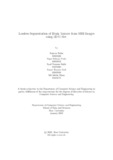| dc.contributor.advisor | Alam, Md. Ashraful | |
| dc.contributor.advisor | Reza, Md Tanzim | |
| dc.contributor.author | Farha, Ramisa | |
| dc.contributor.author | Nuha, Nigar Sultana | |
| dc.contributor.author | Sakib, Syed Nazmus | |
| dc.contributor.author | Rafi, Sowat Hossain | |
| dc.contributor.author | Khan, Md Sabbir | |
| dc.date.accessioned | 2022-09-05T09:33:04Z | |
| dc.date.available | 2022-09-05T09:33:04Z | |
| dc.date.copyright | 2022 | |
| dc.date.issued | 2022-01 | |
| dc.identifier.other | ID 18101406 | |
| dc.identifier.other | ID 18101143 | |
| dc.identifier.other | ID 18101160 | |
| dc.identifier.other | ID 18101140 | |
| dc.identifier.other | ID 18101274 | |
| dc.identifier.uri | http://hdl.handle.net/10361/17166 | |
| dc.description | This thesis is submitted in partial fulfillment of the requirements for the degree of Bachelor of Science in Computer Science, 2022. | en_US |
| dc.description | Cataloged from PDF version of thesis. | |
| dc.description | Includes bibliographical references (pages 37-39). | |
| dc.description.abstract | 2D computer vision and activities related to medical image analysis are remarkably
guided with the help of Convolutional Neural networks (CNNs) in recent years.
Since a chief portion in the available clinical imaging data is in 3D, we are inspired
to further develop 3D CNNs for seeking the advantage of greater spatial context.
Despite the fact that many FCNs are previously worked on and built by using various
approaches, current 3D approaches still rely on patch processing due to the
utilization of GPU memory, which limits the incorporation of bigger context information
for improved performance. Using efficient 3D FCNs in MRI images without
any data loss would result in more efficient disease detections. In this paper, we
propose an approach to an efficient 3D U-net segmentation technique for MRI Images
using a lossless preprocessing of an MRI image dataset. Our proposal has the
advantage of an impressive reduction of the required GPU memory for 3D Medical
Image processing activities and that too, with an enhanced performance which is
evaluated by the IoU (Intersection over Union) evaluation metric. Comprehensive
experiment results performed with MICCAI BraTS’20 exhibit the viability of the
presented strategy. | en_US |
| dc.description.statementofresponsibility | Ramisa Farha | |
| dc.description.statementofresponsibility | Nigar Sultana Nuha | |
| dc.description.statementofresponsibility | Syed Nazmus Sakib | |
| dc.description.statementofresponsibility | Sowat Hossain Rafi | |
| dc.description.statementofresponsibility | Md Sabbir Khan | |
| dc.format.extent | 39 pages | |
| dc.language.iso | en | en_US |
| dc.publisher | Brac University | en_US |
| dc.rights | Brac University theses are protected by copyright. They may be viewed from this source for any purpose, but reproduction or distribution in any format is prohibited without written permission. | |
| dc.subject | 3D CNN | en_US |
| dc.subject | FCNs. | en_US |
| dc.subject | 3D-Unet | en_US |
| dc.subject | Segmentation | en_US |
| dc.subject | Volumetric medical images | en_US |
| dc.subject | 3D medical image processing | en_US |
| dc.subject | Brain 3D MRI | en_US |
| dc.subject.lcsh | Image processing -- Digital techniques. | |
| dc.subject.lcsh | Neural networks (Computer science) | |
| dc.title | Lossless segmentation of Brain Tumors from MRI images using 3D U-Net | en_US |
| dc.type | Thesis | en_US |
| dc.contributor.department | Department of Computer Science and Engineering, Brac University | |
| dc.description.degree | B. Computer Science | |

